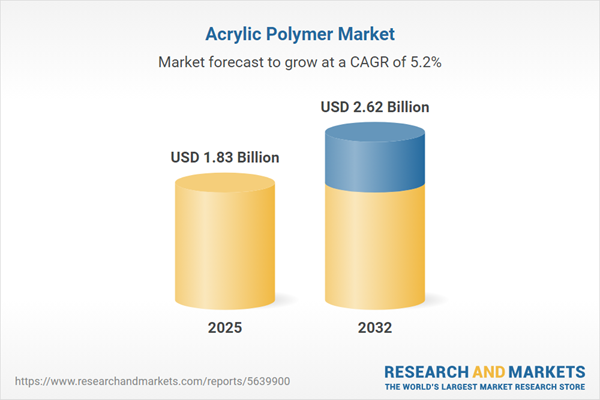Speak directly to the analyst to clarify any post sales queries you may have.
The acrylic polymer market is undergoing transformation, driven by sustainability demands, technological innovation, and changing global trade dynamics. This structured report delivers actionable intelligence for senior decision-makers navigating investment, procurement, and operational strategies within a fast-evolving industry.
Market Snapshot: Acrylic Polymer Market Outlook and Growth Trajectory
The Acrylic Polymer Market grew from USD 1.74 billion in 2024 to USD 1.83 billion in 2025. It is expected to continue growing at a CAGR of 5.24%, reaching USD 2.62 billion by 2032.
This growth reflects robust demand in sectors requiring high-performance polymers and highlights the sector’s shift toward sustainable and advanced material solutions.Scope & Segmentation of the Acrylic Polymer Market
This report provides a detailed assessment of market drivers, challenges, and key opportunities by segment and geography:
- Product Types: Polyacrylamide, Polymethyl Methacrylate, Polyvinyl Acetate, Sodium Polyacrylate
- Solution Types: Solvent-borne, Water-borne
- Forms: Flakes, Granules, Liquid, Powder
- Technologies Used: Bulk Polymerization, Emulsion Polymerization, Solution Polymerization, Suspension Polymerization
- Applications: Adhesives & Sealants, Detergents & Household Care, Paints & Coatings, Paper & Textiles, Water Treatment
- End-User Sectors: Automotive, Chemical, Construction & Building, Electronics & Electricals, Healthcare, Paper & Packaging, Personal Care & Cosmetics, Textile
- Regional Coverage: Americas (United States, Canada, Mexico, Brazil, Argentina, Chile, Colombia, Peru), Europe, Middle East & Africa (United Kingdom, Germany, France, Russia, Italy, Spain, Netherlands, Sweden, Poland, Switzerland, United Arab Emirates, Saudi Arabia, Qatar, Turkey, Israel, South Africa, Nigeria, Egypt, Kenya), Asia-Pacific (China, India, Japan, Australia, South Korea, Indonesia, Thailand, Malaysia, Singapore, Taiwan)
- Company Analysis: Acuro Organics Limited, Anhui Newman Fine Chemicals Co., Ltd., Anshika Polysurf Limited, Arkema S.A, BASF SE, CHEMIPOL, S.A., Evonik Industries AG, Gellner Industrial LLC, H.B. Fuller Company, Jatko, LLC, Kamsons Chemicals Pvt. Ltd., LG Chem, Ltd., Lubrizol Corporation, Makevale Limited, Maxwell Additives Pvt. Ltd., MCTRON Inc., Mitsubishi Chemical Group, NIPPON SHOKUBAI CO., LTD., Nouryon B.V., Protex International S.A, Saudi Basic Industries Corporation, STI Polymer Inc., Sumitomo Seika Chemicals Company, Ltd., Synthomer PLC, The Dow Chemical Company, Toagosei Co., Ltd.
Key Takeaways for Strategic Decision-Making
- Innovation in acrylic polymer chemistries is accelerating realignment across the value chain, with bio-based and waterborne solutions gaining share due to regulatory and environmental demands.
- Regional dynamics are influencing resource allocation, with Asia-Pacific leading in advanced manufacturing and emerging as a pivotal growth hub.
- Collaborations between suppliers and end users, particularly in automotive and electronics, are resulting in tailored resin designs that offer improved durability and targeted performance benefits.
- Digitalization is now integral to process optimization, enabling better monitoring, resource use, and product consistency throughout polymer production.
- Certification requirements and evolving industry standards require manufacturers to continually adapt formulations and processes to meet diverse client and regulatory specifications.
- Growth opportunities are evident in sectors such as water treatment, healthcare, and construction, as these industries increasingly seek polymers with precise attributes and compliant supply networks.
Tariff Impact: Understanding Market Pressures in 2025
New United States tariff schedules effective in 2025 have driven a shift in sourcing and supply strategies for acrylic polymer producers. Importers face higher duties on essential monomers and finished materials, prompting investment in regional production capacity and contract renegotiation. End users, particularly in industrial and specialty goods segments, are adjusting pricing strategies and, in some cases, accelerating adoption of alternative solutions to reduce cost exposure. Firms with integrated supply chains or local production are strategically positioned to mitigate tariff effects and maintain consistent market access.
Methodology & Data Sources
This market analysis is built upon a combination of secondary sources—including industry journals, patent databases, technical papers, and regulatory filings—and primary research, featuring interviews with executives, engineers, and procurement specialists. Data accuracy was verified through cross-validation, and findings were reviewed in a workshop setting with industry experts to validate key conclusions.
Why This Report Matters for Senior Executives
- Enables informed investment decisions in fast-growing and high-value application areas by clarifying product, technology, and regional outlooks.
- Provides risk and resilience assessments around trade policy and tariff scenarios, supporting more robust supply chain development.
- Equips leadership with clarity on evolving regulatory and technology trends essential for futureproofing operations and maintaining compliance.
Conclusion
This report equips industry leaders with a comprehensive perspective on the acrylic polymer market and actionable recommendations for growth and resilience. Decision-makers can leverage these insights to guide portfolio evolution, supply chain optimization, and strategic investment in sustainable innovation.
Additional Product Information:
- Purchase of this report includes 1 year online access with quarterly updates.
- This report can be updated on request. Please contact our Customer Experience team using the Ask a Question widget on our website.
Table of Contents
3. Executive Summary
4. Market Overview
7. Cumulative Impact of Artificial Intelligence 2025
Companies Mentioned
The companies profiled in this Acrylic Polymer market report include:- Acuro Organics Limited
- Anhui Newman Fine Chemicals Co., Ltd.
- Anshika Polysurf Limited
- Arkema S.A
- BASF SE
- CHEMIPOL, S.A.
- Evonik Industries AG
- Gellner Industrial LLC
- H.B. Fuller Company
- Jatko, LLC
- Kamsons Chemicals Pvt. Ltd.
- LG Chem, Ltd.
- Lubrizol Corporation
- Makevale Limited
- Maxwell Additives Pvt. Ltd.
- MCTRON Inc.
- Mitsubishi Chemical Group
- NIPPON SHOKUBAI CO., LTD.
- Nouryon B.V.
- Protex International S.A
- Saudi Basic Industries Corporation
- STI Polymer Inc.
- Sumitomo Seika Chemicals Company, Ltd.
- Synthomer PLC
- The Dow Chemical Company
- Toagosei Co., Ltd.
Table Information
| Report Attribute | Details |
|---|---|
| No. of Pages | 190 |
| Published | November 2025 |
| Forecast Period | 2025 - 2032 |
| Estimated Market Value ( USD | $ 1.83 Billion |
| Forecasted Market Value ( USD | $ 2.62 Billion |
| Compound Annual Growth Rate | 5.2% |
| Regions Covered | Global |
| No. of Companies Mentioned | 27 |









